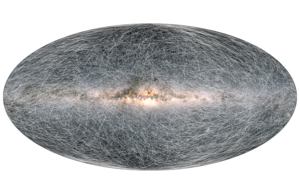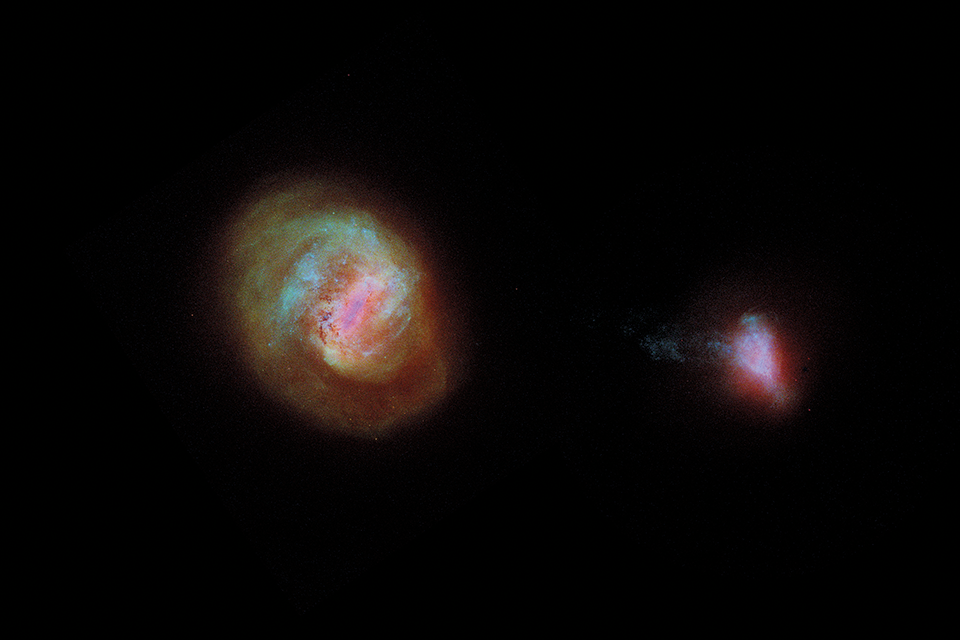Gaia discovers rarely spotted “starquakes” in most detailed galaxy survey to date
Gaia’s latest major data release reveals new detail on nearly 2 billion stars, providing largest ever catalogue of information on stars in our galaxy.

Gaia’s stellar motion for the next 400 thousand years. Credit: ESA/Gaia/DPAC; CC BY-SA 3.0 IGO. Acknowledgement: A. Brown, S. Jordan, T. Roegiers, X. Luri, E. Masana, T. Prusti and A. Moitinho.
- Data forms a multi-dimensional map of asteroids, planets, stars and galaxies that act as a “DNA map” that will revolutionise our understanding of the cosmos
- UK-built technologies crucial to Gaia instruments, including 1-billion-pixel camera
- Findings enabled by Gaia’s first large scale spectroscopy data release
- Release marked by event at Goonhilly Earth Station Ltd in Cornwall, which has been upgraded to receive Gaia data
The Gaia observatory has revealed new data from its travels in space, including tsunami-like starquakes – small movements on stars’ crusts similar to earthquakes we experience on our planet – changing the spherical shape of thousands of stars.
The findings form part of an enormous catalogue of data from objects both inside and beyond our galaxy that could revolutionise astronomy by allowing scientists to test theories about the evolution of stars and the formation of galaxies. Starquakes, also known as non-radial oscillations, are an unexpected discovery, as Gaia was only designed to pick up on radial oscillations that cause stars to change their size.
The Gaia data release was marked by an event at Goonhilly Earth Station Ltd in Cornwall, which is now able to directly receive Gaia data alongside counterpart European Space Agency (ESA) stations across Europe.
Crucial to Gaia’s success are its scientific instruments developed by experts across the UK. These include Chelmsford-based Teledyne e2v, which provided the highly sensitive photon detectors for Gaia’s 1bn pixel camera – the largest focal plane ever flown in space – and Airbus in Stevenage, which designed and built elements such as Gaia’s electrical service module.
The team of scientists and engineers working on Gaia from the UK is led by Cambridge University and supported by a total £23 million of investment from the UK Space Agency and a further £2.4 million from the Science and Technology Facilities Council (STFC).
Science Minister George Freeman said:
This breakthrough by the Gaia observatory in our understanding of the galaxy we live in, the evolution of stars, asteroids and rarely seen starquakes is a major milestone for the space and astronomy community worldwide.
The central role of UK astronomers, instrument engineers and data scientists is a sign of our global leadership in space science and technology, at the heart of our commercial £16.5 billion space tech sector.

Gaia’s view of the Milky Way’s neighbouring galaxies. Credit: ESA/Gaia/DPAC; CC BY-SA 3.0 IGO. Acknowledgement: L. Chemin; X. Luri et al (2020)
Dr Colin Vincent, STFC Associate Director Astronomy, said:
The UK Space Agency and STFC have jointly supported data centres in the UK, which are essential to the exciting science from this unique mission.
By developing and applying advanced data extraction and processing techniques, our UK experts can turn raw data into science to make new discoveries.
As part of a strong international collaboration, the UK continues play such a key part of this scientific endeavour to better understand our galaxy.
Developed by a consortium of 20 countries, including the UK, through ESA, Gaia was launched in 2013 to piece together the largest and most accurate multi-dimensional map of the Milky Way.
As well as starquakes, the spacecraft has now returned findings on binary stars (pairs of stars that revolve around each other or a common centre), moons, around 155,000 asteroids, and numerous of galaxies outside our own, recording details such as distance, motions, chemical compositions, stellar temperatures, colours, masses, ages, and the speed at which stars move towards or away from us (radial velocity).
The new data release also includes Gaia’s first major release of spectroscopy data, which measures the absorption and splitting of starlight.
The Large and Small Magellanic Clouds (two dwarf galaxies orbiting the Milky Way) colour-coded by stellar density
Dr Nicholas Walton, Institute of Astronomy at University of Cambridge and member of the ESA Gaia Science Team, said:
This major data release from Gaia not only allows astronomers to map the distances and motions of some two billion stars in our galaxy, but it also gives detailed measures of the physical and chemical makeup of a large number of those objects for the first time.
With this incredible database we can build a comprehensive picture of the Milky Way and delve into its incredible history of formation, seeing direct evidence of both violent past interactions with other galaxies, and internal bouts of intense star formation along its spiral arms.
This new data release creates a detailed bank of information, essentially working as a DNA map that allows us to understand the stellar population of our Galaxy, and track its past, present and future.
The UK space sector employs 47,000 people and generates an income of £16.5 billion, with the number of space organisations growing across the UK.
Matthew Cosby, Chief Technology Officer at Goonhilly Earth Station Ltd, said:
We are very grateful to the Gaia team for supporting the commissioning of Goonhilly’s Deep Space Antenna, which now allows us to receive data directly from the observatory.
We are thrilled to be hosting the UK event for the latest Gaia data release in celebration of this milestone, and we look forward to being an integral part of the Gaia journey.
You can see more of the latest images, footage and data from the data release on the ESA web page.